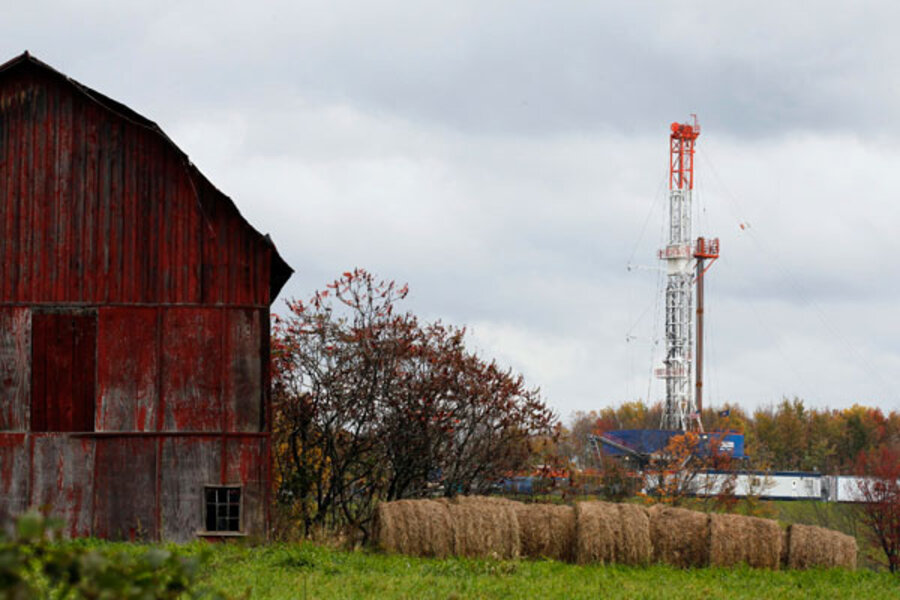Natural gas 'fracking' has flipped US energy map, study says
Loading...
Natural gas pipelines that for a half century sent natural gas flowing northward from energy-rich Gulf Coast states to heat and power the megacities of the chilly Northeast are seeing a role reversal. Northeast shale-gas discoveries are now being pumped in the opposite direction to meet rising industrial demand in the Southeast.
That switch in the status quo presents enormous infrastructure challenges while also promising big economic gains. Existing natural gas pipelines configured to send natural gas northward for winter heating and electricity generation will have to be reconfigured to send new gas supplies in the opposite direction, according to a new national study of gas demand.
As a result, at least 40 Northeast gas pipeline expansions are planned, with 20 geared toward sending gas to the Southeast, according to the new report by Bentek Energy, a subsidiary of Platts, a global energy information provider.
“Based on our latest modeling, the US is embarking on a true sea change,” said Rocco Canonica, lead author of the 10-year outlook, in a statement. “The Northeast is poised to switch from the nation’s largest demand region to a net supply region, and the US Southeast is racing to become a much larger net demand region after being a major supplier to the US gas market.”
More than one-third of projected growth in US natural gas production between 2013 and 2023 is expected in the Northeast region in just two massive shale beds called the Marcellus and Utica formations. As a result of new gas flowing from the Northeast as well as Texas and North Dakota, gas prices have fallen by half compared with the 2005-2010 average.
That steep drop is driving a wave of US industrial projects from fertilizer plants to manufacturing to electric power generation. Nearly half of that new growth in US natural gas demand is expected in the Southeast region, the report found.
Everyone from President Obama to environmentalists and energy company officials touts the virtues of the new natural gas bounty, especially in replacing more heavily polluting coal-power generation – and boosting the US economy with low-cost energy.
But those vast new reserves of low-cost natural gas are extracted through the controversial drilling technique known as hydraulic fracturing or “fracking” and have changed the nation’s energy equation in some unexpected ways. Cheap shale gas has, for instance, torpedoed construction of costly new nuclear-power plants and hampered low-cost renewable wind-power.
Yet US industrial demand for that cheap gas has gas-reliant industries booming. Nationwide, about 360 new industrial projects worth about $116 billion have been announced, the Bentek study found. Of that group, about 135, worth roughly $72 billion, are in development in the Southeast.
Methanex is a case in point. The Canadian company recently announced it will relocate two methanol production plants to the US Gulf Coast from Chile, citing abundant low-cost natural gas as a “prime determinant.”
The Southeast shifted to being a “net demand region” in 2012, when it started taking in more gas than it was delivering to other regions. The north-south flow reversal is likely to bring with it a long-term rise in gas prices.
It also comes during a growing national debate over whether the Obama administration should approve 10 or more facilities that would export liquified natural gas (LNG). Industrial groups that benefit from the low-cost natural gas are challenging the LNG export proposals, because exporting gas would lower the amount available in the US, raising prices.
Nine LNG export projects are currently planned in the Southeast, the Bentek report says.
In early August, the US Department of Energy granted its third conditional permit for such a facility to move forward. But final approval for the project is still pending, with the DOE saying it would “assess the impact of any market developments on subsequent public interest determinations” when “further information becomes available at the end of 2013.”
The DOE could pull the plug if future LNG projects likely will cause gas prices to rise, energy analysts say. That's why big industrial companies are lining up against a bill in the House of Representatives that would remove DOE from the approval process. As they prepare to spend billions on facilities that count on cheap natural gas to operate, these companies want to make sure the DOE remains as potential check.
Said Paul Cicio, president of the Industrial Energy Consumers of America, in a statement Monday: “Because DOE approval of an LNG export application can be for 20-30 years, and because a lot can happen to either domestic consumption or production during that time frame, it is very important that great caution is used when considering an application to export LNG.”








